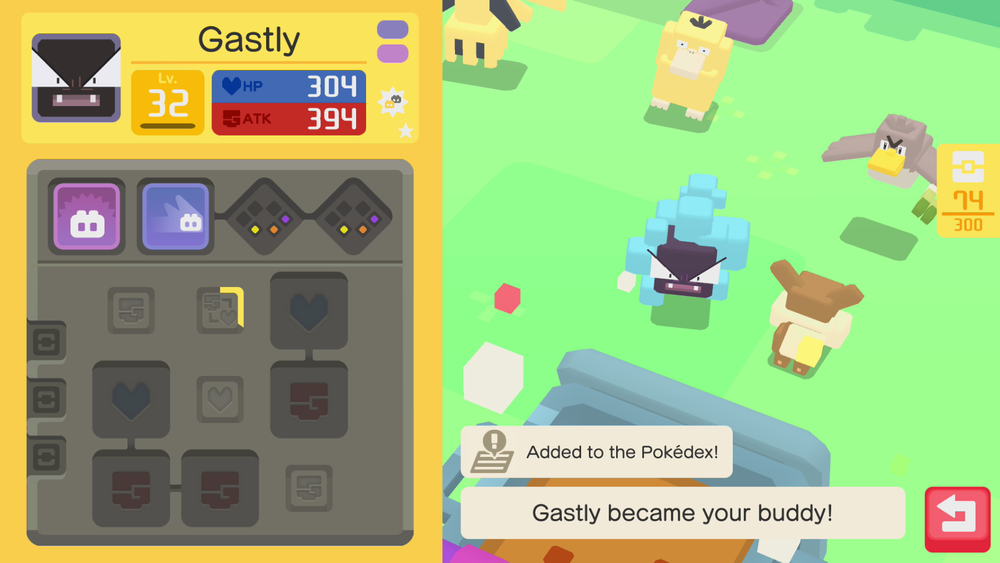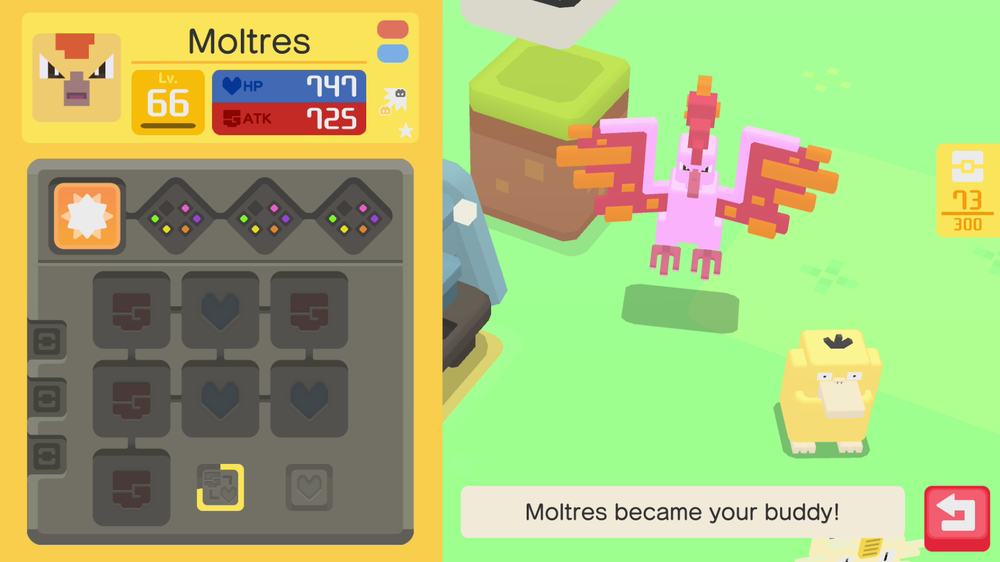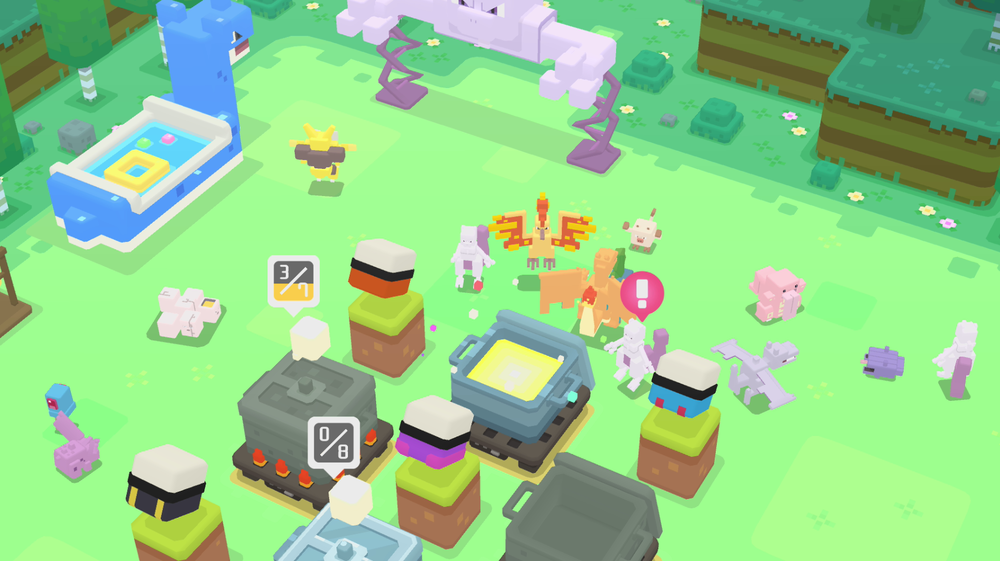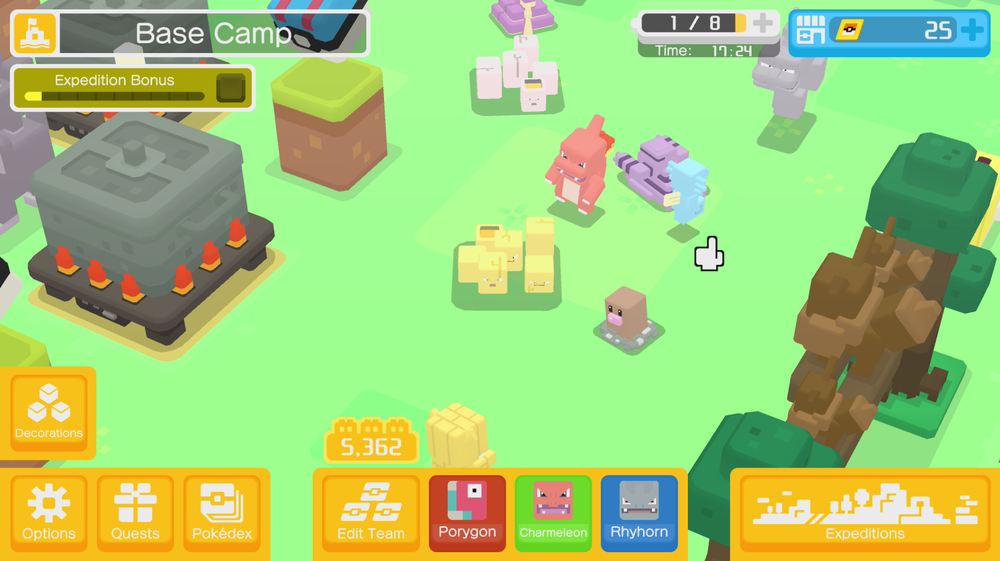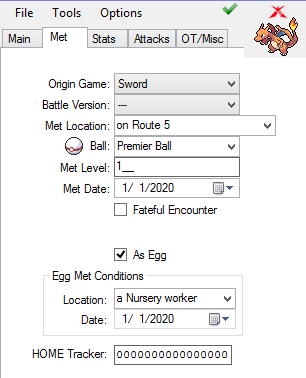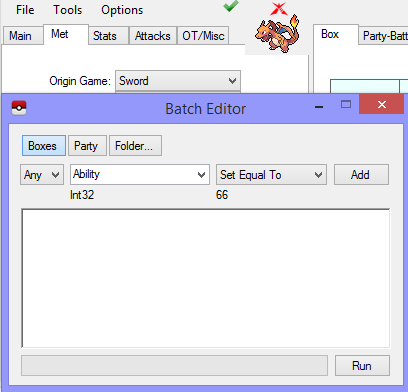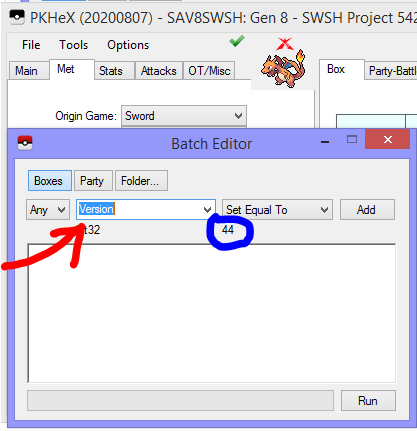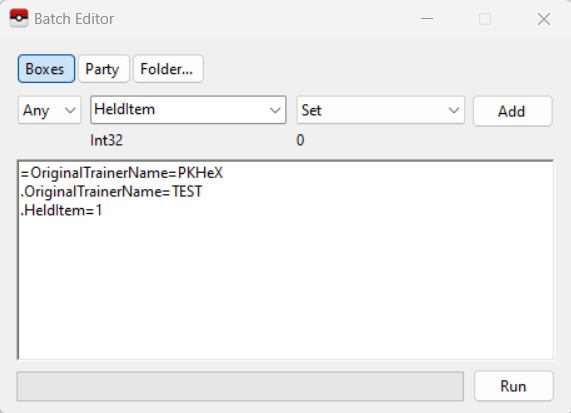-
Posts
202 -
Joined
-
Last visited
-
Days Won
5
Content Type
Profiles
Pokédex
Portal
Technical Documentation
Pages
Tutorials
Forums
Events
Downloads
Gallery
Blogs
Everything posted by NinFanBoyFTW
-
I'm pretty sure that every pokemon can be transferred to pokemon home, but then they will have to sit in limbo until probably the next remakes or games. I am hoping that they could patch the games later on to support the other pokemon. One reason they might do this is because unlike all of the previous games, the save is on the console and not on the cartridge. The cartridge only contains the game data so it would be pretty easy to patch the game and not have to worry about someone trying to load their 1.2 save for example on a 1.0 copy of the game. I'm really annoyed about this though, I would have rather waited another 6 months or whatever it would take.
-

LGPE - Pokémon Pass Shiny Pikachu/Eevee Gift
NinFanBoyFTW replied to theSLAYER's topic in Event Pokémon News
Hey guys I have 1 extra code if anyone wants it. U901-4ATV-7EXP-48Y6 -
In this tutorial you will learn how to back up your Nintendo switch saves using a homebrew program called JKSV. The latest version of JKSV can be downloaded from here. Note: This guide is meant for CFW emuNAND extracting from/importing to CFW emuNAND, or CFW sysNAND extracting from/importing to CFW sysNAND. It's not meant for CFW emuNAND extracting from/importing to Stock sysNAND. In this unintended case, it may work for some of the readers, but note that the sysNAND and emuNAND may unlink at any time, causing this unintended consequence to stop working. The only real fix that we know thus far, is creating a new emuNAND using the present sysNAND. As a side note, this is done without “Export to Zip” being toggled off. (For JKSV 11/05/2024) This can be changed by scrolling down to the end of the user selection menu and opening the settings menu 0. Download JKSV.nro from their Github page, from the latest release. Then place it into the Switch folder of your SD card. 1. Launch the Homebrew Menu from your Switch and look for JKSV. Then launch JKSV by pressing "A" 2. Pick your desired user 3. Navigate to your desired game 4. Press "A" to select your desired game. Then press "A" to begin backing up your save 5. Enter a name for your new save. Then click on the "Accept" button or click "+" to complete the backup process. 6. If the backup has completed you will see a new save with the name you chose under your desired game. 7. Turn your Switch off, insert your SD card into your computer and Navigate to "JKSV". Then find your desired game in the list of games. 8. Open your desired game's folder. Inside will be the folder you named in step 5. Note: this folder will contain all of the subsequent backups you make of this game. 9. Navigate through the folder of the backup you created and you will find your save file. Note: this step may be different and the resulting save file may be different depending on the game you have chosen. 10. MAKE A BACKUP OF THIS FILE BEFORE USING OR EDITING IT WITH ANY SAVE EDITORS. Note: LGPE -> savedata.bin SWSH -> main, backup and poke_trade. Use main with PKHeX. Note: Switch Cartridges do not store saves. So whether physical or digital copy, the saves all goes into your Switch, and that is what this tool is dumping. View full tutorial
-
In this tutorial you will learn how to back up your Nintendo switch saves using a homebrew program called JKSV. The latest version of JKSV can be downloaded from here. Note: This guide is meant for CFW emuNAND extracting from/importing to CFW emuNAND, or CFW sysNAND extracting from/importing to CFW sysNAND. It's not meant for CFW emuNAND extracting from/importing to Stock sysNAND. In this unintended case, it may work for some of the readers, but note that the sysNAND and emuNAND may unlink at any time, causing this unintended consequence to stop working. The only real fix that we know thus far, is creating a new emuNAND using the present sysNAND. As a side note, this is done without “Export to Zip” being toggled off. (For JKSV 11/05/2024) This can be changed by scrolling down to the end of the user selection menu and opening the settings menu 0. Download JKSV.nro from their Github page, from the latest release. Then place it into the Switch folder of your SD card. 1. Launch the Homebrew Menu from your Switch and look for JKSV. Then launch JKSV by pressing "A" 2. Pick your desired user 3. Navigate to your desired game 4. Press "A" to select your desired game. Then press "A" to begin backing up your save 5. Enter a name for your new save. Then click on the "Accept" button or click "+" to complete the backup process. 6. If the backup has completed you will see a new save with the name you chose under your desired game. 7. Turn your Switch off, insert your SD card into your computer and Navigate to "JKSV". Then find your desired game in the list of games. 8. Open your desired game's folder. Inside will be the folder you named in step 5. Note: this folder will contain all of the subsequent backups you make of this game. 9. Navigate through the folder of the backup you created and you will find your save file. Note: this step may be different and the resulting save file may be different depending on the game you have chosen. 10. MAKE A BACKUP OF THIS FILE BEFORE USING OR EDITING IT WITH ANY SAVE EDITORS. Note: LGPE -> savedata.bin SWSH -> main, backup and poke_trade. Use main with PKHeX. Note: Switch Cartridges do not store saves. So whether physical or digital copy, the saves all goes into your Switch, and that is what this tool is dumping.
-
3DS versions don't have to do with PKHeX. You just need to get access to homebrew or CFW, and backup your save file which PKHeX is always going to be compatible with.
- 1 reply
-
- question
- Compatibility
-
(and 1 more)
Tagged with:
-
You need homebrew. Then you need to use checkpoint to backup and restore your save
-
Wow this is actually ridiculous now. I literally opened up the next pot right after my shiny Moltres and I got another shiny (2 shinies in a row) I know that the odds of a shiny are much much higher than the normal games but this is just hilarious.
-
Hahahaha. I just randomly got a shiny Moltres. Even though I used cheats for getting more materials and tickets, there are no hacks yet for changing pokemon to shiny. This is awesome. I also got a shiny Cubone the other day but I forgot to post it.
-
Pretty happy right now. Someone just released a Pokemon Quest Save Editor that gives you max ingredients and max tickets. Makes the game so much more fun (especially because I paid $30 for the expansion packs and I felt like I got almost nothing). Also I was getting extremely tired of grinding the same exact level 20 times and having to wait hours. You can find the Editor here: https://github.com/Thealexbarney/PqSave/releases
-
I actually can't believe it but somehow I got a shiny Pokemon in Pokemon quest already. I'm not sure what the odds are for this but It's still pretty cool. I have only found a few shiny pokemon ever in all of my Pokemon games but somehow I have found one shiny in the original Pokemon rumble for wii and now Pokemon Quest lol. Post replies with your own shiny Pokemon if you find one.
-
You don't need a 3.0.0 switch to homebrew (and most likely CFW) your switch. They have homebrew up to the latest firmware now, with that hardware exploit they found. Here is a tutorial
-
Hey I'm not sure if you still need any other information but my Batch editor guide has all of the values for met location Just scroll down to met location and open it up.
-
This tutorial will show to to activate PKHaX mode on PKHeX. This mode will allow you to give Pokemon illegal abilities, stats, and much more. Please Note: "Project Pokémon does not support or condone cheating at the expense of others. While this community contains research, information, and utilities allowing people to create their own Pokémon, we do not agree with using them against players who are unaware that significantly hacked" Please visit the following page for more information about Project Pokemon's Cheating Policy: Making your own batch file for PKHaX is fairly simple. In this tutorial, the resulting batch file will be identical to the file I provided above, but will not have an icon, and will be in a ".bat" format instead of a ".exe" format. 1. Navigate to a folder to make the batch file. Right click inside of the folder, then click on "new", then click on "Text Document" 2. Rename the new text file to whatever you like (I will rename mine "PKHaX"). 3. Open your new text file, then paste in this code start pkhex hax exit 0 4. Click on "File" then click on "Save As" 5. When the "Save As" window comes up, add ".bat" as shown in the picture below, to the end of your file name. Then click "Save" 6. Go back to the folder in which you just saved your new batch file. Make sure you are using the batch file and not the text file. 7. Move the batch file you just created into the same folder as PKHeX. Then open your PKHaX batch file and PKHeX with PKHaX mode should open correctly. View full tutorial
-
This tutorial will show to to activate PKHaX mode on PKHeX. This mode will allow you to give Pokemon illegal abilities, stats, and much more. Please Note: "Project Pokémon does not support or condone cheating at the expense of others. While this community contains research, information, and utilities allowing people to create their own Pokémon, we do not agree with using them against players who are unaware that significantly hacked" Please visit the following page for more information about Project Pokemon's Cheating Policy: Making your own batch file for PKHaX is fairly simple. In this tutorial, the resulting batch file will be identical to the file I provided above, but will not have an icon, and will be in a ".bat" format instead of a ".exe" format. 1. Navigate to a folder to make the batch file. Right click inside of the folder, then click on "new", then click on "Text Document" 2. Rename the new text file to whatever you like (I will rename mine "PKHaX"). 3. Open your new text file, then paste in this code start pkhex hax exit 0 4. Click on "File" then click on "Save As" 5. When the "Save As" window comes up, add ".bat" as shown in the picture below, to the end of your file name. Then click "Save" 6. Go back to the folder in which you just saved your new batch file. Make sure you are using the batch file and not the text file. 7. Move the batch file you just created into the same folder as PKHeX. Then open your PKHaX batch file and PKHeX with PKHaX mode should open correctly.
-
In this tutorial you will learn how to properly use the Batch Editor in PKHeX. The batch editor, when utilized fully and correctly, can be an extremely useful tool for fixing, and editing Pokemon. Please Note: The Batch Editor does NOT have an undo option and therefore all actions taken with the Batch Editor are FINAL unless you quit PKHeX without saving. As a result. MAKE SURE YOU HAVE BACKUPS OF YOUR SAVE BEFORE YOU EDIT IT WITH THE BATCH EDITOR. Section 1: Basic Fundamentals and operation of the Batch Editor The Batch editor works on the simple premise that all possible characteristics pertaining to a Pokemon, boil down to a set of numbers which correspond to certain values in the Pokemon games themselves. Because of this, changing, and editing Pokemon using the Batch Editor is like a mathematical statement, with if then, and true/false statements. The basic operators of the Batch Editor are: "." = Sets the desired value Equal to the value you input "=" = Narrows the editing of Pokemon down to the Pokemon which have the same value as your input value "!" = Narrows the editing of Pokemon down to the Pokemon which do not have the same value as your input value. As an example of how these operators are used, Once you select a variable you would like to change (OT Name, Pokemon Species, Pokemon Level, etc...) and the correct operator, click "Add". This will add your desired variable with your desired operator in the correct format. The next step is to create the formula in which the Batch Editor will run. As an example of a possible combination for use in the Batch Editor, the following formula will change the OT trainer name on Pokemon with a specific OT to a specified OT trainer name, as well as give every Pokemon with that filter, a Master Ball to hold. =OriginalTrainerName=PKHeX This line instructs the Batch Editor to narrow it's scope down to every Pokemon with the OT Trainer Name "PKHeX" .OriginalTrainerName=TEST This lines instructs the Batch Editor to set the OT Trainer Name for all of the previously filtered Pokemon to "TEST" .HeldItem=1 This line instructs the Batch Editor to set the Held Item for all of the previously filtered Pokemon to a Master Ball - which Item Index number is 1. Some Special Tricks to use in the Batch Editor, Courtesy of @Kaphotics (Creator of PKHeX) The Batch Editor window references the PKM that is currently viewed in the editing tabs. If you select a property name, the Batch Editor will indicate whether or not the tabs PKM has that property. If the tabs PKM has that property, the Batch Editor will display the property's current value as well as the data type (number, text, etc). To Randomize a PID, use ".PID=$rand". To Randomize EncryptionConstant, use ".EncryptionConstant=$rand" To Randomize a value within a range, use ".Nature=$x,y" for an inclusive range of [x,y]. To make a Pokémon Shiny: use ".PID=$shiny". To copy the Encryption Constant to the PID, use ".EncryptionConstant=PID" To delete a Pokémon, use ".Species=0" To set a date (Met / EggMet), use yyyyMMdd for the string. Example: ".MetDate=20160409" will set the Met Date to April 9th, 2016. Suggestions can be automatically applied for Moves, RelearnMoves, and Met_Location. Example: ".Moves=$suggest" will retrieve and apply suggested moves from the legality interpreter, same as if you clicked on the Moves groupbox in the tabs editor. Legality can be used as a filter. Use "=Legal=false" to only modify illegal Pokémon. A full up to date list is available by reading the Pokémon properties from the PKHeX source code Section 2: ID Numbers for Use with the Batch Editor This section will focus on the input values you can use in conjunction with the Batch Editor. The Batch Editor uses the in-game index values to set the desired properties to Pokemon. Because of this you will need to use said index numbers instead of relying on the standard text based input present in PKHeX. As an example, to set the species of a Pokemon using the Batch Editor, you must use the equation .Species=150 Not .Species=Mewtwo Below are many of the common variables you may want to use, along with the possible values to use with those variables. Please Note: Some variables (like location, items etc...) have different ID numbers for different generations. Please ensure that you are using the correct ID numbers that correspond to the generation of the game you are editing. Ability: AbilityNumber: Form: Ball: Box: CanGigantamax ConsoleRegion: Country: CurrentFriendship: CurrentLevel: DynamaxLevel: TeraTypeOriginal and TeraTypeOverride: EggLocation: EggMetDate: EV_ATK, EV_DEF, EV_HP, EV_SPA, EV_SPD, EV_SPE: FatefulEncounter: Gender: HeldItem: HPType: IsEgg: IsNicknamed: IV_ATK, IV_DEF, IV_HP, IV_SPA, IV_SPD, IV_SPE: Language: Legal: MarkCircle, MarkDiamond, MarkHeart, MarkSquare, MarkStar, MarkTriangle: MetLevel: MetLocation: MetDate: Move1, Move2, Move3, Move4: Move1_PPUps, Move2_PPUps, Move3_PPUps, Move4_PPUps: Nature: Nickname: OriginalTrainerGender: OriginalTrainerName: PID: RelearnMove1, RelearnMove2, RelearnMove3, RelearnMove4: Ribbons ShinyLeaf (Gen 4 HG/SS Only) SID16 or TrainerSID7: TID16 or TrainerTID7: Slot: Species: Stat_ATK, Stat_DEF, Stat_HP, Stat_SPA, Stat_SPD, Stat_SPE: Version: JUST IN CASE ANY OF THE VALUES ABOVE ARE NOT UPDATED: You can use Batch Editor to also view the particular values you want. Special Thanks to @theSLAYER for help with making and researching this guide with me
-
In this tutorial you will learn how to properly use the Batch Editor in PKHeX. The batch editor, when utilized fully and correctly, can be an extremely useful tool for fixing, and editing Pokemon. Please Note: The Batch Editor does NOT have an undo option and therefore all actions taken with the Batch Editor are FINAL unless you quit PKHeX without saving. As a result. MAKE SURE YOU HAVE BACKUPS OF YOUR SAVE BEFORE YOU EDIT IT WITH THE BATCH EDITOR. Section 1: Basic Fundamentals and operation of the Batch Editor The Batch editor works on the simple premise that all possible characteristics pertaining to a Pokemon, boil down to a set of numbers which correspond to certain values in the Pokemon games themselves. Because of this, changing, and editing Pokemon using the Batch Editor is like a mathematical statement, with if then, and true/false statements. The basic operators of the Batch Editor are: "." = Sets the desired value Equal to the value you input "=" = Narrows the editing of Pokemon down to the Pokemon which have the same value as your input value "!" = Narrows the editing of Pokemon down to the Pokemon which do not have the same value as your input value. As an example of how these operators are used, Once you select a variable you would like to change (OT Name, Pokemon Species, Pokemon Level, etc...) and the correct operator, click "Add". This will add your desired variable with your desired operator in the correct format. The next step is to create the formula in which the Batch Editor will run. As an example of a possible combination for use in the Batch Editor, the following formula will change the OT trainer name on Pokemon with a specific OT to a specified OT trainer name, as well as give every Pokemon with that filter, a Master Ball to hold. =OriginalTrainerName=PKHeX This line instructs the Batch Editor to narrow it's scope down to every Pokemon with the OT Trainer Name "PKHeX" .OriginalTrainerName=TEST This lines instructs the Batch Editor to set the OT Trainer Name for all of the previously filtered Pokemon to "TEST" .HeldItem=1 This line instructs the Batch Editor to set the Held Item for all of the previously filtered Pokemon to a Master Ball - which Item Index number is 1. Some Special Tricks to use in the Batch Editor, Courtesy of @Kaphotics (Creator of PKHeX) The Batch Editor window references the PKM that is currently viewed in the editing tabs. If you select a property name, the Batch Editor will indicate whether or not the tabs PKM has that property. If the tabs PKM has that property, the Batch Editor will display the property's current value as well as the data type (number, text, etc). To Randomize a PID, use ".PID=$rand". To Randomize EncryptionConstant, use ".EncryptionConstant=$rand" To Randomize a value within a range, use ".Nature=$x,y" for an inclusive range of [x,y]. To make a Pokémon Shiny: use ".PID=$shiny". To copy the Encryption Constant to the PID, use ".EncryptionConstant=PID" To delete a Pokémon, use ".Species=0" To set a date (Met / EggMet), use yyyyMMdd for the string. Example: ".MetDate=20160409" will set the Met Date to April 9th, 2016. Suggestions can be automatically applied for Moves, RelearnMoves, and Met_Location. Example: ".Moves=$suggest" will retrieve and apply suggested moves from the legality interpreter, same as if you clicked on the Moves groupbox in the tabs editor. Legality can be used as a filter. Use "=Legal=false" to only modify illegal Pokémon. A full up to date list is available by reading the Pokémon properties from the PKHeX source code Section 2: ID Numbers for Use with the Batch Editor This section will focus on the input values you can use in conjunction with the Batch Editor. The Batch Editor uses the in-game index values to set the desired properties to Pokemon. Because of this you will need to use said index numbers instead of relying on the standard text based input present in PKHeX. As an example, to set the species of a Pokemon using the Batch Editor, you must use the equation .Species=150 Not .Species=Mewtwo Below are many of the common variables you may want to use, along with the possible values to use with those variables. Please Note: Some variables (like location, items etc...) have different ID numbers for different generations. Please ensure that you are using the correct ID numbers that correspond to the generation of the game you are editing. Ability: AbilityNumber: Form: Ball: Box: CanGigantamax ConsoleRegion: Country: CurrentFriendship: CurrentLevel: DynamaxLevel: TeraTypeOriginal and TeraTypeOverride: EggLocation: EggMetDate: EV_ATK, EV_DEF, EV_HP, EV_SPA, EV_SPD, EV_SPE: FatefulEncounter: Gender: HeldItem: HPType: IsEgg: IsNicknamed: IV_ATK, IV_DEF, IV_HP, IV_SPA, IV_SPD, IV_SPE: Language: Legal: MarkCircle, MarkDiamond, MarkHeart, MarkSquare, MarkStar, MarkTriangle: MetLevel: MetLocation: MetDate: Move1, Move2, Move3, Move4: Move1_PPUps, Move2_PPUps, Move3_PPUps, Move4_PPUps: Nature: Nickname: OriginalTrainerGender: OriginalTrainerName: OriginalTrainerTrash / HandlingTrainerTrash NicknameTrash PID: RelearnMove1, RelearnMove2, RelearnMove3, RelearnMove4: Ribbons ShinyLeaf (Gen 4 HG/SS Only) SID16 or TrainerSID7: TID16 or TrainerTID7: Slot: Species: Stat_ATK, Stat_DEF, Stat_HP, Stat_SPA, Stat_SPD, Stat_SPE: Version: JUST IN CASE ANY OF THE VALUES ABOVE ARE NOT UPDATED: You can use Batch Editor to also view the particular values you want. Special Thanks to @theSLAYER for help with making and researching this guide with me View full tutorial
-
If you aren't using the latest build, here it is. Try it and see if your issue is resolved, because I'm pretty sure that they have been fixing multiple issues with pokemon showdown import. PKHeX.zip
-
Hi. Do you have the latest GitHub build of PKHeX or are you using the latest release of PKHeX from Project Pokemon
-
Use my guide on importing saves. You need to run your game at least once so that the save folder gets created
-
Here you go. main The Dialga is in the PC, otherwise you wouldn't be able to pick up your starter. All of these pokemon are legal (except the Latias until you level it up) so once your playthrough is over, these will be legal. Added all items except for HMs because I think it can mess up certain story events.
-
Ill make one for you. Give me a few minutes Edit: what trainer name do you want
-
Yeah it's an issue PKHeX has with the pokespot pokemon. Something about the way they are generated in the game is hard for PKHeX (at this time) to determine if they are legal.
-
Hi. This is a known issue I raised. It requires more research so for now it isn't going to be resolved, but don't worry about your pokemon not being legal. They should be fine. https://github.com/kwsch/PKHeX/issues/1359
-
This tutorial will show you how and where to access your save files while using a Wii emulator. This guide will cover the most popular emulator for running Wii games: Dolphin (Computer). This guide assumes that you have already set up and played one of these emulators at least once. Scroll down to your emulator of choice. This is not a setup guide. This guide is meant to show where to find or inject your save files. Dolphin (Computer): 1. Open up Dolphin 2. Right click on your desired game. Then click on "Open Wii save folder" 3. Inside this folder will be your save file. Note: depending on the game you chose this step will look different. 4. MAKE A BACKUP OF THIS FILE BEFORE USING OR EDITING IT WITH ANY SAVE EDITORS. View full tutorial
-
- 1
-

-
This tutorial will show you how and where to access your save files while using a Wii emulator. This guide will cover the most popular emulator for running Wii games: Dolphin (Computer). This guide assumes that you have already set up and played one of these emulators at least once. Scroll down to your emulator of choice. This is not a setup guide. This guide is meant to show where to find or inject your save files. Dolphin (Computer): 1. Open up Dolphin 2. Right click on your desired game. Then click on "Open Wii save folder" 3. Inside this folder will be your save file. Note: depending on the game you chose this step will look different. 4. MAKE A BACKUP OF THIS FILE BEFORE USING OR EDITING IT WITH ANY SAVE EDITORS.



